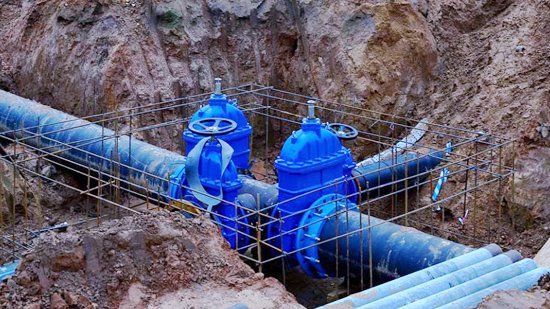Where Does a Sanitary Plumbing System Begin and End?
A sanitary plumbing system begins at the point where wastewater is generated and ends at the point where it is safely disposed of or treated. This system plays a crucial role in maintaining public health and preventing the spread of diseases.
It starts with the collection of wastewater from various sources such as toilets, sinks, and showers. This wastewater is then transported through a network of pipes and drains to a treatment facility or a septic tank, where it is treated and disposed of in an environmentally friendly manner.

Photo by pmengineer
Proper installation and maintenance of a sanitary plumbing system are essential to ensure the efficient and safe disposal of wastewater, protecting both individuals and the environment from potential health hazards.
Sanitary Plumbing Systems
Sanitary plumbing systems play a crucial role in maintaining public health and hygiene by safely transporting waste and sewage away from homes and buildings.
Modern Infrastructure
Sanitary plumbing systems serve as the backbone of modern infrastructure, ensuring that waste is effectively and safely carried away from residential and commercial spaces.
Basic Components
The basic components of a sanitary plumbing system include pipes, fittings, traps, vents, and various fixtures such as sinks, toilets, and showers, all working together to safely and efficiently manage wastewater.
See More: What is Sanitary Plumbing: Your Ultimate Solutions
Starting Point: The Origin Of Waste
Understanding where a sanitary plumbing system begins and ends is crucial for maintaining a clean and healthy environment. The starting point of this system lies in the origin of waste, which can be traced back to various sources, including household fixtures and commercial or industrial establishments.
Household Fixtures
Household fixtures play a significant role in generating waste that requires proper disposal. These fixtures include toilets, sinks, showers, and bathtubs. Each of these fixtures is connected to a network of pipes that carry waste materials away from the home.
When you flush the toilet or drain water from the sink, the waste is transported through a series of interconnected pipes. These pipes are designed to maintain a consistent flow and prevent blockages, ensuring that waste reaches its final destination without any issues.
It is important to note that household fixtures are not the only sources of waste in a sanitary plumbing system. Commercial and industrial establishments also contribute to the overall waste generated.
Here’s another post you might find useful: What is Sanitary Fittings in Plumbing?
Commercial and Industrial Sources
Commercial and industrial sources produce a substantial amount of waste that needs to be properly managed. These sources include restaurants, offices, factories, and other similar establishments.
Restaurants, for example, generate waste from their kitchen sinks, dishwashers, and toilets. Offices produce waste from bathroom facilities, such as toilets and sinks, as well as from break rooms and cafeterias.
Industrial facilities, on the other hand, generate waste from various processes and operations specific to their industry. This waste can be in the form of liquids, solids, or gases, and it requires specialized plumbing systems to handle its disposal safely.
Proper waste management in commercial and industrial settings is crucial to prevent environmental pollution and ensure the health and safety of both employees and the surrounding community.
The starting point of a sanitary plumbing system begins with the origin of waste. This waste can come from household fixtures, such as toilets and sinks, as well as from commercial and industrial sources.
Understanding where waste originates is essential for designing and maintaining an efficient and effective plumbing system that promotes cleanliness and sustainability.
The Journey Through Pipes
A sanitary plumbing system is a critical aspect of any building, as it ensures the safe and efficient disposal of wastewater. But have you ever wondered where the journey of this wastewater begins and ends?
Types Of Pipes Used
Various types of pipes are used in a sanitary plumbing system, each with its own unique properties and advantages. Some of the most commonly used pipes include:
| Pipe Type | Description |
|---|---|
| PVC | A lightweight and durable pipe that is easy to install and resistant to corrosion. |
| Copper | A long-lasting pipe that is resistant to corrosion and can withstand high temperatures and pressures. |
| Cast Iron | A strong and durable pipe that is ideal for carrying heavy loads and is resistant to fire and corrosion. |
Gravity Flow Vs. Forced Flow
When it comes to the movement of wastewater through a plumbing system, there are two main methods: gravity flow and forced flow. Gravity flow relies on the natural downward movement of wastewater, while forced flow uses a pump to move the wastewater through the pipes.
Gravity flow is the most common method used in residential buildings, as it is simple and cost-effective. However, forced flow is often necessary in commercial and industrial buildings where large volumes of wastewater need to be moved quickly and efficiently.
Regardless of the method used, it is important to ensure that each part of the plumbing system is properly designed and installed to prevent blockages and leaks.
A sanitary plumbing system is a complex network of pipes that plays a critical role in the safe and efficient disposal of wastewater. By understanding the journey that wastewater takes through these pipes and the different types of pipes and methods used, we can ensure that our plumbing systems are functioning properly and effectively.
Ventilation: An Essential Aspect
Ventilation is an essential aspect of sanitary plumbing systems, ensuring the proper flow of air and water. The system begins at the fixtures, where wastewater is produced, and ends at the vent stack on the roof, allowing odors and gases to escape.
Proper ventilation is crucial for maintaining the integrity of the plumbing system.
Preventing Negative Pressures
One of the critical aspects of the ventilation system in a sanitary plumbing system is preventing negative pressures. Negative pressures can cause the water in the plumbing system to siphon away, leading to low water pressure and even backflow. This can contaminate the water supply and pose a severe health risk.
Types Of Plumbing Vents
There are two main types of plumbing vents: the soil stack and the vent stack. The soil stack runs vertically through the building and connects to the drainage system. It collects wastewater from toilets, showers, and sinks and carries it down to the sewer or septic tank.
The vent stack runs parallel to the soil stack and connects to the outside air. It allows air to flow freely in and out of the plumbing system, which prevents negative pressures from occurring.
Importance Of Ventilation
Ventilation is an essential aspect of a sanitary plumbing system because it helps to maintain the proper balance of pressure in the pipes. When wastewater flows out of a plumbing fixture, it creates a vacuum effect, which can cause negative pressures in the system. Without proper ventilation, this can lead to siphoning and backflow, which can be dangerous to human health.
Additionally, ventilation helps to remove unpleasant odors and gases from the plumbing system. Without proper ventilation, these odors and gases can build up and seep into the building, causing discomfort and health issues. Ventilation also helps to prevent the buildup of moisture in the pipes, which can lead to the growth of bacteria and mold.
Traps: Unsung Heroes
In a sanitary plumbing system, traps play a crucial role, yet they often go unnoticed and unappreciated. These simple devices are the unsung heroes of the plumbing world, quietly performing a vital function that protects our homes and buildings from unpleasant odors and harmful gases.
Understanding the function and importance of traps, as well as the common types available, is essential for anyone seeking to grasp the inner workings of a plumbing system.
Function and Importance
Traps are designed to prevent foul odors and harmful gases from entering buildings through the drainage system. They achieve this by creating a water seal that effectively blocks the passage of gases and odors while still allowing waste water and solids to flow through. This simple yet ingenious mechanism ensures that our living and working spaces remain safe, hygienic, and odor-free.
Common Types Of Traps
There are several types of traps commonly used in sanitary plumbing systems, each with its own unique features and applications. Some of the most widely used types of traps include:
- P-trap: Features a U-shaped pipe that holds water to create a seal, commonly used under sinks and basins.
- S-trap: Resembles the shape of the letter “S” and is often found in older plumbing systems, particularly for floor drains.
- Bottle trap: Compact and space-saving, this trap is commonly utilized in modern bathroom fittings and vanity units.
- Grease trap: Specifically designed to prevent grease and oil from entering the drainage system, often used in commercial kitchens.
Treatment: Transformation Stage
The treatment stage marks the transformation of wastewater into a form that is safe for disposal or reuse.
Septic Systems
Septic systems are individual wastewater treatment setups commonly used in rural areas.
- Consist of a septic tank and a drain field
- Wastewater is treated and filtered naturally
- Effluent is absorbed into the soil
Municipal Sewage Treatment
Municipal sewage treatment facilities process wastewater from homes and businesses in urban areas.
- Wastewater enters treatment plants through sewer systems
- Physical, biological, and chemical processes are used
- Cleaned water is released back into the environment
Final Destination: Return To the Environment
Water Bodies
Sanitary plumbing systems play a crucial role in ensuring that the waste and wastewater from our homes and buildings are safely and efficiently transported to their final destination: the environment. Once these waste and wastewater materials reach the sewer system, they eventually make their way to various water bodies such as rivers, lakes, and oceans.
It’s essential for the sanitary plumbing system to be properly designed and maintained to prevent any harmful impact on these water bodies.
Reuse And Recycling
Reusing and recycling of water is an important aspect of environmental sustainability. Sanitary plumbing systems are designed to facilitate the collection and treatment of wastewater, allowing for the safe reuse and recycling of water resources.
This includes processes such as greywater recycling, which involves treating water from sources such as sinks and showers for non-potable uses like irrigation and flushing toilets.
By incorporating reuse and recycling practices, sanitary plumbing systems contribute to the conservation of water resources and the reduction of environmental impact.
Maintenance And Challenges
The sanitary plumbing system begins at the building’s sewer or septic tank and ends at the point where waste is treated or discharged. Maintenance involves preventing clogs, leaks, and blockages, which can pose significant challenges for proper functioning. Regular inspections and professional cleaning are essential for a well-maintained system.
Maintenance and Challenges The sanitary plumbing system requires consistent maintenance to ensure optimal functionality and prevent potential issues. Routine checks and cleaning play a crucial role in preserving the efficiency of the system.
Identifying common issues and implementing effective solutions is imperative for a seamless sanitary plumbing system. Routine Checks and Cleaning Performing routine checks on the sanitary plumbing system is essential to detect any potential issues before they escalate.
This includes inspecting pipes, drains, and fixtures for leaks, clogs, or corrosion. Regular cleaning of drains and pipes helps prevent blockages and buildup of debris, ensuring smooth water flow.
Common Issues and Solutions Common issues in sanitary plumbing systems include leaks, clogs, and sewer line backups. Leaks can be addressed through timely repairs and the application of sealants.
Clogs are often resolved using drain snakes or environmentally friendly enzyme cleaners. Sewer line backups may require professional assistance for thorough inspection and cleaning.
By conducting routine checks and implementing timely solutions, the maintenance of a sanitary plumbing system can be effectively managed, promoting longevity and efficient operation.
Conclusion
The journey of a sanitary plumbing system starts with careful planning and ends with efficient waste disposal. Understanding this flow is crucial for maintaining a healthy and functional plumbing system in any building. Remember, proper installation and regular maintenance are key to a smoothly operating system.



